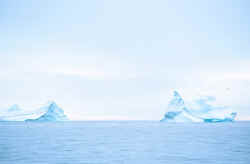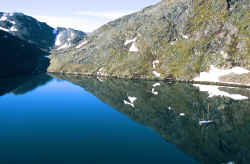 The
last one hundred miles we follow the Bowdoin's inshore route, around
Cape White Handkerchief, inside Big White Bearskin Island, anchoring in
Sea Plane Cove, rounding Cape Kakkiviak and Black Rock Point. Although
we work close inshore for much of this passage, the 100-mile run is indeed
treacherous. Ledges, fog, rocks, (charted and not) and exceptionally severe
tide rips ring the passage. Most of this coast is only partially charted,
even today. Soundings are often represented only by a narrow "strip
survey", conducted in large part by "Mac" in the Bowdoin.
MacMillan would often run close inshore early in the season to work the
shore leads in the ice, but there has been little incentive in intervening
the years for others to stay so close inshore. The "ledge strewn
coast" even precludes one from calling it quits and heading back
out for the open Labrador Sea. Once on this inshore route, you're committed
to stay the course until completing the passage. Charts drawn well before
my birth, with newly affixed warning stickers proclaiming in red letters
that the "horizontal datum" has not been reconciled with modern
GPS or Loran systems, require that one's piloting skills constantly remain
sharp. The prudent mariner is cautioned to expect errors of up to one
half mile. The option is to use the offshore route for this part of the
voyage.
The
last one hundred miles we follow the Bowdoin's inshore route, around
Cape White Handkerchief, inside Big White Bearskin Island, anchoring in
Sea Plane Cove, rounding Cape Kakkiviak and Black Rock Point. Although
we work close inshore for much of this passage, the 100-mile run is indeed
treacherous. Ledges, fog, rocks, (charted and not) and exceptionally severe
tide rips ring the passage. Most of this coast is only partially charted,
even today. Soundings are often represented only by a narrow "strip
survey", conducted in large part by "Mac" in the Bowdoin.
MacMillan would often run close inshore early in the season to work the
shore leads in the ice, but there has been little incentive in intervening
the years for others to stay so close inshore. The "ledge strewn
coast" even precludes one from calling it quits and heading back
out for the open Labrador Sea. Once on this inshore route, you're committed
to stay the course until completing the passage. Charts drawn well before
my birth, with newly affixed warning stickers proclaiming in red letters
that the "horizontal datum" has not been reconciled with modern
GPS or Loran systems, require that one's piloting skills constantly remain
sharp. The prudent mariner is cautioned to expect errors of up to one
half mile. The option is to use the offshore route for this part of the
voyage.
In
2001, while approaching the northern tip of Labrador on the inshore route,
another gale threatened. Seeking refuge in Williams Harbour, 60º
00'N, 64º 15'W, it seemed as though we had returned to winter. The
weather was a stiff northeast gale with driving sleet and snow, dense
fog, and an ambient water temperature of 37º F. We were now in the
heart of the Torngat. Torngat, to the Labrador Inuit, is the Abode of
the Evil Spirits. For nearly a week we remained in Williams Harbor, as
an unending succession of gales swept through Hudson Straits and around
Cape Chidley, just to our north. When we entered this harbor, on July
21st, the clear sky and gentle easterly belied what would be to come,
but afforded an excellent view of the fjord and the surrounding mountains.
For most of our stay we were able to see little of the Abode, but we were
certainly able to hear the Spirits wail.
Of the modern contraptions that we have aboard for entertainment and reference, a complete collection of National Geographic since its inception, all on computer CDs, tops the list. During our stay in Williams Harbour we had plenty of time to read, and a few articles by or about Donald Macmillan and the schooner Bowdoin were of great interest to us. For those readers interested, see the November 1923, March 1926, and particularly the October 1951 issues.
As the series of gales began to abate, the barometer began to rise rapidly. The next day dawned clear and sunny, revealing a heavy blanket of fresh snow on all of the nearby mountain peaks. But there was little time to enjoy the revealed beauty of our surroundings, as the passing of the front that had obscured our view was accompanied by a 40K westerly blowing down the long Tellialuk Fjord, directly into the entrance to Williams Harbor. The time had come for us to depart, as we were no longer offered sanctuary by Torngak.
 We
made our way north, past a number of stunning fjords. Each time we passed
an inlet we were blasted by the katabatic wind pouring down from the great
mountains to the west. No sea was up though, as the wind was offshore.
Past Martin Bay, now known to have been the site of a secret German weather
station during World War II, Ikkudliayuk Fjord, Clark Harbor, and out
through a narrow entrance between rocks, breakers and tiny Amity Island.
Through this entrance set a huge easterly swell, the remainder of the
week's northeasterly gales. Although it drained just about the last of
our adrenaline reserves, we punched our way out through the swell, making
for the open sea. For the time being anyway-- in ten miles or so we would
reenter MacGregor Straits between the Cape Chidley Islands and Killinek
Island, off the northern tip of Labrador.
We
made our way north, past a number of stunning fjords. Each time we passed
an inlet we were blasted by the katabatic wind pouring down from the great
mountains to the west. No sea was up though, as the wind was offshore.
Past Martin Bay, now known to have been the site of a secret German weather
station during World War II, Ikkudliayuk Fjord, Clark Harbor, and out
through a narrow entrance between rocks, breakers and tiny Amity Island.
Through this entrance set a huge easterly swell, the remainder of the
week's northeasterly gales. Although it drained just about the last of
our adrenaline reserves, we punched our way out through the swell, making
for the open sea. For the time being anyway-- in ten miles or so we would
reenter MacGregor Straits between the Cape Chidley Islands and Killinek
Island, off the northern tip of Labrador.
On our 2001 voyage, a heavy swell breaking completely across its ninety-meter
wide entrance, forced us to pass by Bowdoin Harbour where we had
hoped to pay homage to "Mac" and the Bowdoin. In 2002
and 2004 we approached Bowdoin Harbour in calm weather and passed through
the narrow entrance easily. Once inside one is well protected from wind
and sea, as well as ice. While anchored inside in 2004 we had a late night
polar bear visit. Mark was awakened by strange water sounds outside the
stern. As he went topside he noticed that the wheel was moving from side
to side. As he looked over the side he spotted a polar bear with his paws
on the boat, apparently attempting to board the boat. He decided that
this behavior needed to be discouraged and returned below for the shotgun.
I was awakened to Mark yelling "Get out of hear," immediately
followed by a gun blast, each done three times. By the time I got on deck
the visitor had swum to shore, paced the shore in the water several times
before finally climbing ashore and lumbering off.
A few miles north of Bowdoin Harbor is the northern most anchorage on the Labrador, O'Brien Harbour. At the head of O'Brien Harbor is a small amphitheatre, ringed by 1,800 foot peaks rising directly from the sea. The anchorage is very well sheltered from the sea, but a place certain to experience severe williwaws when the wind gets up. Our first visit in 2001 required anchor watches, with the engine warmed up and ready, during our first night, as rock walls surrounded us only a few meters distant. The powerful williwaws continuously spun us round and round on our anchors. At times it seemed as though we were about to be knocked down, under bare poles, on the anchor, but then the wind would sheer and assault us from a different direction. By the next morning all was quiet and calm.
A beautiful Arctic high greeted us on both our stays in 2001 and 2002. In 2001 we were able to go ashore for water and hike up the ridge for some great photos. Because of the very great tides in Hudson Strait, we planned to depart at high water slack to enjoy a favorable current as we swung northeast out to sea. In final tribute, as though to reward our tenacity, old Torngak had a special treat awaiting us as we neared the harbor entrance. In the current in the straits a number of herds of Harp seals swam in groups like synchronized Olympic competitors. Perched as far out on the point of rocks as he could get was a solitary male polar bear, earnestly hoping one unwary member of the water follies would stray near enough that he might be afforded dinner. Working our way in as close as was prudent in an area poorly charted, we rolled videotape and snapped camera shutters in the fervent hope that some sort of image would emerge to enable us to support our claim.
During
our visit to O'Brien in 2002 we planned to go ashore and hike to our friend's,
Chris and Anni Law, cairn and add a message to the bottle they placed
there 20 years prior. We got up very early so as to get ashore and hike
up to the cairn before the harsh light of midday. Mark had gone on deck
to prepare the dinghy, which we had launched the evening before, for our
excursion. I was inside getting our camera gear ready, when Mark suddenly
popped his head inside and whispered, "Nancy, grab the cameras and
the shotgun, and get up on deck quickly. There's a polar bear swimming
around the boat." At first it didn't sink in, but then suddenly I
was very excited and terrified.
On
deck I remained in the cockpit, stretching my neck, trying to peer over
the side, not knowing exactly where to find the bear. Slowly he began
to float aft, along the starboard side, and came into view, less than
10 feet away. While I shot with the video camera, Mark shot with the still
camera, at the same time holding the shotgun. Binky, the name we gave
our visitor, just tread water next to the boat, watching us, while we
remained alert, anticipating his next move. Eventually he just swam towards
shore where he found a comfortable rock in the sun and remained for the
next 24 hours. Needless to say, we never went to shore during that stay
and left the next morning, Binky was still sleeping on shore.
Click below to view video of polar bear encounter